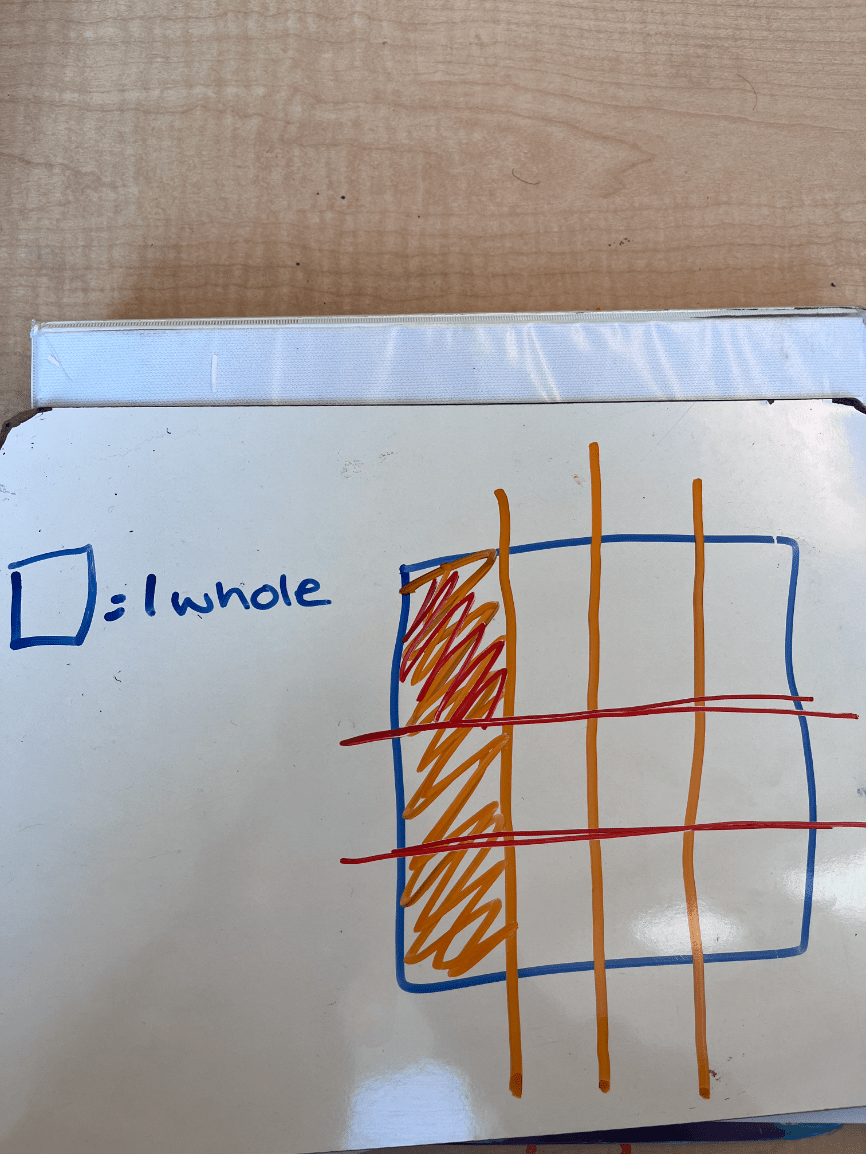What is the answer to the following problem?
2/4 * 3/5
3/10
Which direction do you move the decimal point when multiplying by a power of 10?
Which direction do you move the decimal point when dividing by a power of 10?
You move the decimal to the right when multiplying by a power of 10
You move the decimal to the left when dividing by a power of 10
A candy bar costs $0.98. You have $5.00.
Can you buy 5 candy bars?
Explain your reasoning.
Yes you can buy 5 candy bars. 5 x 1.00= 5.00 and 0.98 is less than 1.00 so our product (or the cost to buy all 5 bars) will be less than $5.00
Write and solve the equation the represents the following problem
Talia has 4 feet of ribbon. She wants to cut it into pieces that are each ⅓ of a foot long.
How many pieces can she cut?
4 div 1/3
12 pieces of ribbon
Represent the following in two different ways that does not use a fraction
*Bonus points: Represent the following in two different formats*
1/4
0.25,0.250,0.2500 etc

1 div 4
Write two measurements that are equivalent to 120 centimeters?
1.2 m
1,200 mm
0.0012 km
Write the equation that represent the problem and solve it using a representation of your choice
A recipe uses ⅗ of a cup of sugar for one batch of muffins. If you want to make ¾ of a batch,
how much sugar will you need?
¾ c × ⅗ of a batch =¾ cups for the batches
Look at the work below. A student was solving:
0.46 × 0.3
Student’s Work:
46 × 3 = 138
Final answer: 1.38
Without solving is the student correct?Explain how you know.
No they are not correct
They placed thee decimal incorrectly.They should have counted the total number of decimal places in the problem:
0.46 has 2 decimal places
0.3 has 1 decimal place
So the product should have 3 decimal places
Also both factors are less than one so we know our product has to be less than 1
A class of 6 students is sharing 3.6 pounds of clay equally to make identical clay models.
Each model uses 0.3 pounds of clay.
How many models can each student make?
Each student can make 2 models
3.6 ÷ 6 = 0.6 pounds per student
0.6 ÷ 0.3 = 2 models per student
Write a story problem that goes with this representation, and write the equation that

Any story problem that represents ¼ × ⅓
214 x 7 = 1498
214 x __= 14.98
Without using multiplication/division. What is the value of the second factor and how do you know
214 x 7 = 1498
214 x 0.07= 14.98
Our product got smaller by 2 powers of 10 (or 100) and our first factor did not change which means our missing factor has to also be 2 powers of 10 (or 100) times smaller than 7.
7 / 100 = 0.07
Grapes cost $3.85 per pound. You buy 2.6 pounds.
You estimate the total cost by rounding:
$3.85 → $4.00
2.6 pounds → 2.5 pounds
So your estimate is: $4.00 × 2.5 = $10.00
Will the actual total be more or less than $10.00?
Explain how you know without multiplying the exact numbers.
The actual total will be slightly more than $10.00
You rounded the price up (from $3.85 to $4.00), which would normally make the product higher
But you rounded the weight down (from 2.6 to 2.5), which would make the product lower
Since you rounded the price up a little, but rounded the pounds down even more, the decrease in weight has a bigger effect
So the actual total ends up a bit more than your estimate — but not by much
Solve the following problem, showing all work
Danielle has 2¼ yards of fabric. Each small pillow uses ¾ of a yard, and each mini pillow uses ⅜ of a yard.
She wants to make 2 small pillows first, and then use the leftover fabric to make mini pillows.
How many mini pillows can she make?
2 mini pillows
Find how much fabric 2 small pillows use:
2 × ¾ = 1½ yardsFind how much fabric is left:
2¼ − 1½ = ¾ yard leftDivide the remaining fabric by ⅜ to find how many mini pillows:
¾ ÷ ⅜ = 2 mini pillows
Explain why your quotient will always be more than the dividend WHEN your dividend is a whole number and your divisor is a fraction.
(*hint*drawing the problem out may help in your explanation)
Ex:
5 div 1/6 = 30
When you break a whole number up into small pieces you end up with a large number of pieces
Our divisor is decreasing which means we have smaller groups (smaller jumps) so we need more groups (more jumps) to reach the same place
A student solved this problem:
"A ribbon is 144 centimeters long. Each small bow takes 0.25 meters of ribbon.
How many bows can be made?"
Student’s Work:
"0.25 × 100 = 25 cm
144 ÷ 25 = 5.76
Final Answer: 6 bows"
Is the student correct?
If yes, explain why.
If no, identify the mistake and give the correct answer.
The student is not correct.
They converted units correctly: 0.25 meters = 25 centimeters.
And they divided correctly: 144 ÷ 25 = 5.76.
BUT they should not round up. You can’t make 0.76 of a bow unless you're told you can.
The correct answer is: 5 full bows.